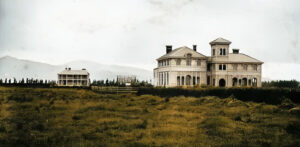1856: The Christchurch Club
June 27, 2024
By AHNZ
 The Christchurch Club (est. 15 March 1856) was an institution of the ‘Squattocracy’ during the era when this class of men were the power in New Zealand. Their 1860s building (left) is still on the corner of Worcester Street and Latimer Square in Christchurch today.
The Christchurch Club (est. 15 March 1856) was an institution of the ‘Squattocracy’ during the era when this class of men were the power in New Zealand. Their 1860s building (left) is still on the corner of Worcester Street and Latimer Square in Christchurch today.
In his Dune saga, science fiction author Frank Herbert moved a family dynasty that relied upon sea and air power to a new, dry, planet. “Here, we must scrabble for desert power,” it was realised and much of the books explore what that means as an economic base. Canterbury (est. 1850,) as founders Edward Wakefield and John Godley et al thought, was to be based on mixed farming power. But, they were wrong.
Sheep Power was the key to Canterbury, as the early adopters in the form of the Deans Brothers had already correctly figured out several years before. Ref. 1843: Ovis Aries Canterbury, AHNZ
The so-called Shepherd Kings of Tussock Country, or Squattocracy, emerged as the new power brokers in early colonial New Zealand. Those with sheep to graze could lease vast lands and multiply their capital several times over. Until about 1880 these grass-powered empires in the South Island flourished and dominated the entire country. Each had its own grand estate house standing as a castle within empires of grass employing thousands of men, dogs, and horses. To name a few: Mesopotamia, Mt Algidus, Cheviot, Homebush, The Levels, Terrace Station, Glenmark,..
When business necessitated coming into the city (Christchurch proclaimed as such in 1854, showing these Sheep Kings imposing their way..) the Lords needed a venue. That was what the Christchurch Club was for. According to Cumberland (1981) in the first decade, 40 members were on the Canterbury Provincial Council or in national parliament. Four of New Zealand’s Prime Ministers at the time were drawn from the small population of men who were masters of one of these great estates. They tended to be descended from upper class gentry so were well versed in the classics and Latin which, it seems to me, they used to gate-keep New Zealand’s levers of power within a particular social set.
As well as being a very early gentleman’s club, rugby and squash also got their boost if not their very start thanks to these men. They even got a Royal Charter.
“When Canterbury was colonised in 1850 the idea was to build a province out of small mixed farms. On paper, a good idea. Upon arrival it turned out that pasturalism-by-sheep was the winning combo and administrator John Godley had to break some rules and think on his feet.” – 1843: Ovis Aries Canterbury, AHNZ
“Due to the composition of its membership, the Christchurch Club was “an informal seat of power in nineteenth century Canterbury.” – Wiki
“The Christchurch Club was established on 15 March 1856 for Canterbury landholders who required accommodation when visiting Christchurch…The wives and children of club members, however, were required to lodge elsewhere.” – Canterbury Stories
On 24 June, 1998, The Club yielded to Politically Correct pressure to permit women as full members in their own right.
Prior to this, since 1969, women could only be associate members if they were daughters, wives, or sisters of existing members.
The change came during the dismal era of Satanic Panic and Victimhood Culture (1991-1995), a particularly misguided and hysterical chapter in New Zealand’s history.
—
Image ref. Christchurch Club, 26 November 1861. Alfred Charles Barker, Canterbury Museum, Digital NZ. Augmented by AHNZ (2024)
 Like Comment Share
Like Comment Share





